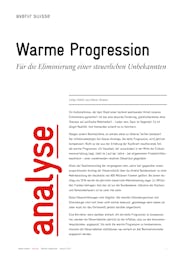An automatic mechanism that guarantees the state a steadily growing share of our income: that would be an absurd demand, fortunately one that would stand no chance of getting a political majority, right? Unfortunately not. On the contrary: it’s long been a reality. And nobody seems to care.
If our nominal pay rises, it’s taxed at higher rates. The inflation-related part of this increase, bracket creep, is compensated annually by adjusting the brackets in the tax tables accordingly. If, however, the purchasing power of our pay increases as a result of general productivity growth, then the increase is not compensated in the tax tables. This is real bracket creep. For example, a household that remains in the middle of the income distribution has to pay an increasing share of its income to the state in the form of taxes over the years.
Effects of real bracket creep
Real bracket creep affects everyone: In a progressive tax system, the average tax rates of all taxpayers rise continuously, provided that the economy achieves real wage growth. As a result, government revenues rise disproportionately to the nationwide value added. Productivity growth or the resulting real wage growth thus leads, via real bracket creep, to a creeping increase in the fiscal quota and thus also in the public spending ratio.
Ironically, real bracket creep has a degressive effect: it reduces the redistribution from rich to poor. This is because the majority of the progressive taxation effect in Switzerland affects medium-high rather than extremely high incomes. Because real bracket creep puts a larger share of households in the highest tax bracket, the share that very rich households – i.e. the top few percent – contribute to the total tax volume decreases. Here are some figures: Among married people, the general increase in real wages over the past ten years has meant that the highest-income 5 percent of households paid “only” 60.6 percent of the federal tax bill in 2019, compared with 63.3 percent ten years earlier.
The precise extent of real bracket creep
The 8.4 percent increase in real wages from 2010 to 2020 has led to households paying CHF 800 million more in direct federal tax alone as a result of real bracket creep than they would have to if their tax liability had also increased “only” proportionally, i.e. by 8.4 percent. An increase of 20 percent from today’s level would lead to an annual additional tax burden of CHF 2.4 billion. And that’s only at the federal level. Including cantonal and communal taxes – which, although they usually have a lower progression, are four times the volume of direct federal taxes – it’s much more.
These tax increases have little justification. Most voters are not even aware of them, let alone have they (or even parliament) ever voted on them.
A way of compensating for real bracket creep
It would be easy to remedy the situation: To offset real bracket creep, the tax tables could be adjusted annually to inflation, i.e. to the consumer price index. To offset (inflation-related) bracket creep, the tax tables would have to be adjusted to the nominal wage index instead. Compensating for inflation-related bracket creep would in no way mean the state was “starved to death.” On the contrary, it would probably continue to grow. Tax revenues would increase at the rate of nominal income growth. The compensation mechanism would merely prevent them from rising disproportionately to income growth. Should such a disproportionate growth of the tax volume be desired in the future, it would have to be legitimised by a referendum.






